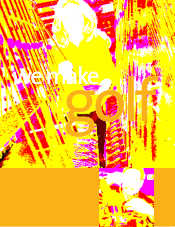Callaway 2000 Annual Report Download - page 12
Download and view the complete annual report
Please find page 12 of the 2000 Callaway annual report below. You can navigate through the pages in the report by either clicking on the pages listed below, or by using the keyword search tool below to find specific information within the annual report.
While it is true that professionals and highly skilled amateurs also have long used our clubs with great
success, we fundamentally design our products for the average mid-to-high handicap golfer or recre-
ational player. It happens that the Callaway Golf design features that benefit the average golfer – for-
giveness, accuracy, and the chance to achieve extra distance off the tee – also benefit the highly
skilled player.
This year we are making explicit in our corporate mission what has always been implicit: We intend to
grow the game by helping people enjoy the game. That means:
■We will continue to create the very best “tools” for all golfers – from recreational golfers to the most
highly skilled professionals. Our drivers will be easier to hit and designed to deliver maximum distance
from a well struck tee shot and maximum forgiveness on off-center hits. Our fairway woods will help
golfers get the ball in the air quickly. Our irons will be built to be forgiving and even more accurate than
ever before. Our putters will be the best-engineered to get the ball rolling sooner to keep putts on line and
our golf balls will deliver state-of-the-art aerodynamics, better feel, better distance and more durability.
■In the United States, where the USGA and other groups have chosen to try to prohibit the use of modern
thin-faced drivers approved almost everywhere else in the world, we will offer our very best driver – the
Big Bertha ERC II Forged Titanium Driver – only
for use in recreational or social rounds of golf. In
this way, the great many golfers who seldom play
in competitive tournaments can enjoy the benefits
of this exceptional golf club (which is approved by
the R&A for use by all golfers in all rounds out-
side North America) without needing to challenge
the U.S. competitive rules.
■We will continue to invest in the design of
equipment that will make the game perhaps a
little bit more enjoyable for the average, recre-
ational player. In the vast majority of cases, we
expect that these products will fully conform to
the Rules of Golf. Indeed, all of our current prod-
ucts, including the ERC II Driver, conform to the
Rules of Golf as published by the Royal and
Ancient Golf Club of St. Andrews, Scotland, the
oldest governing body in golf and the one that sets the rules in all but three countries in the world.
We believe in the Rules of Golf governing play and our only disagreement with the USGA is over its
interpretation of the equipment rule governing so-called “spring-like effect” in a driver.
■We believe that the best thing that can happen quickly for the game of golf is for the USGA to drop
its distance restriction on drivers so we can return to having one set of equipment rules worldwide.
We have hoped that others associated with the game of golf would support our focus on growing the
game, and in some cases our hopes have been rewarded. Outside the United States, it is our view that
the R&A has been sensitive to the desires and needs of the average golfer when exercising its authori-
ty. The R&A’s attitude that extra distance off the tee does not pose any threat to the integrity of the
game – even from highly skilled professionals – has been reflected in the impressive acceptance of the
ERC II Driver on the PGA European Tour, where it was the #1 driver model after the first seven weeks of
competition. Perhaps these are some reasons why the game has seen its greatest growth internationally
in the areas governed by the R&A.
Our greatest disappointment has been with the USGA and other bodies in the United States who are
insistent that the drivers used by average amateurs should be subjected to the same design limitations
Callaway Golf Company | 6
























